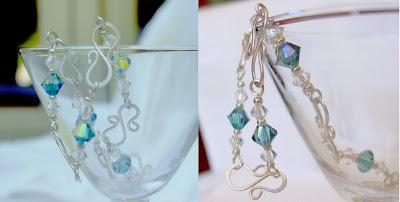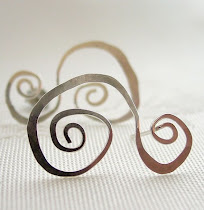It took me a lot of trial and error to get my photos to an acceptable stage. (I say "acceptable", because there is always room for improvement.)
In 2006, I decided to start selling on etsy. But I never set up an online shop until September 2007.
What happened?
I had such a disasterous experience with my first photos that I gave up the idea of selling online. They were so awful, that I knew no one would buy a single thing. It took me over a year to try again.
My first attempts weren't that good. But I kept reading advice in the Etsy forums, asking for and getting feedback, and slowing improving.
With that said, let me summarize my personal tips on photography, the ones that really made a difference to my photos. (BTW, all my photos are taken with a Sony Cybershot, which is a pretty basic digital camera.)
1) Use the proper color temperature/light balance setting on your camera. If you are shooting outside or with a natural daylight bulb, make sure your camera settings are for outdoor pictures. If you are shooting inside, use the indoor settings. (Don't use the Automatic setting. Your camera is not always right. Believe me. I've learned.)
Below is an example. On the left I used the wrong setting. This photo was taken outdoors but the camera's light setting was set to indoors. The picture has a blue cast to it. On the right, the picture was taken with the outdoor setting used; the colors are more true-to life. (Actually, neither photo is great. They were taken before I learned to use my macro setting.)

Here's another example using a lightbox and a daylight bulb. On the left, I took the picture with the camera set to indoors, on the right it's set to outdoors. The background is the same in each: dark grey.

Makes a huge difference, doesn't it. Not only is the background close to the original color, but now the gemstones really "pop".
2) Control the exposure time of your pictures. This is useful if your photos are extremely washed out (too much exposure) or dull/dark (too little exposure). The range on most cameras is -2 to 2 and is usually set to 0 by default. A setting of +1 is a good place to start.
Here is an example in a lightbox. The exposure for the left picture is +1, the middle is 0, and the right picture is at -1. Depending on the ambient lighting and the background, the optimal exposure will vary.

In this case, a setting between +1 and 0 would probably be best.
3) Use optimal lighting. Natural diffused daylight is best. 2nd best is a lightbox. (Never use your flash, at least on jewelry- it can create a one dimensional washed out look.)
Get a lightbox or make one. Then you won't have to rely on the sun all the time. It's easy to make one; here's a few links.
This is what the construction of my light box looks like. I also added white tissue paper to the top and sides to diffuse light from a couple of daylight or full spectrum bulbs. I use flourescent bulbs because they don't heat up so much. Since I used things around my house, the only cost was for the bulbs.
 4) Use the macro setting on your camera
4) Use the macro setting on your camera if you are photographing small items or want to take detailed close-up shots. (The icon is a little flower.) This setting helps your camera focus on small details within your image. You will either need a really steady hand or you might consider using a tripod.
Here's an example of the kind of detail you can get with the macro setting. Guess which picture was taken using the macro lens setting!

With out the macro setting, I would have to take the photo several feet farther from the item. I would lose detail, even if I cropped the photo severely.
5) Use a photo editing program. A photo can be saved with cropping and brightening. Some things I usually use to improve my photos are increasing contrast, gamma correction, increasing or decreasing the saturation, and sharpening.
Photoshop is a great program for editing. But some free (and simpler) programs include Picassa and Photofiltre.
Here's an example of a photo in which the exposure is too dark, and the overall arrangement not aesthetically pleasing. After some major cropping, and color and lighting adjustments, you can see the result:

This made a huge difference. The colors in the background and in the rose quartz stone are now true. The result is that this photo almost doesn't look bad!
6) Your background should complement your item. It should never be so busy that they interfere with seeing it. (You usually can't go wrong with simple white or grey.)
If you have a fun item, go ahead and experiment with fun and bright backgrounds - as long as they don't detract the focus away from the subject.
Here's a few great examples that I found on Etsy. (You might be able to recognize a couple of sellers from their photograpy.

If If you find something that works, stick with it. A lot of successful sellers have unique styles that make them instantly recognizable. (I haven't acheived this yet, but I'm still working on it.)
7) Look on Etsy for ideas! There's a lot of great inspiration out there.
If you'd be interesting in subscribing to my blog and receiving it by e-mail, just click
Subscribe to Contrariwise ramblings by Email

 Makes a huge difference, doesn't it. Not only is the background close to the original color, but now the gemstones really "pop".
Makes a huge difference, doesn't it. Not only is the background close to the original color, but now the gemstones really "pop".


Photography is a love-hate thing isn't it? lol
you have really perfected your craft.
LOVE IT!
Most items that I photograph are too big for a lightbox (unless it was huge). But I can try your other tips right away. Yay!
http://www.alankarshilpa.blogspot.
com
Http;//www.bead-z-mommys-business.com